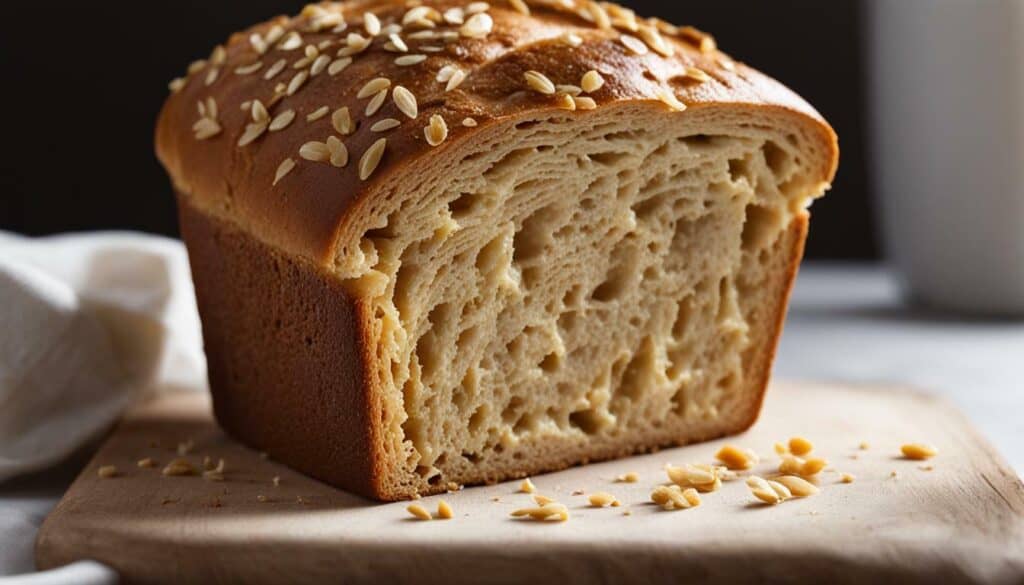Welcome to my personal guide on the calories in bread with butter. In this comprehensive article, we will uncover the truth about the nutritional content of this popular food combination.
- Calculating the calories in bread can be done by adding up the calories of the individual ingredients and dividing it by the weight of the baked bread.
- The calorie counts for different types of bread can vary, so it’s important to choose healthier options like whole grain bread or bread alternatives.
- Toppings and spreads can contribute significant calories, so opting for low-calorie alternatives like vegetables and healthier spreads is advisable.
- Be cautious of the calorie content in pre-made sandwiches from convenience stores or restaurants, as they tend to be higher in fat and calories.
- Being mindful of ingredients, portion sizes, and making informed choices can help create a healthier and lower-calorie bread and butter sandwich.
Calculating the Calories in Bread with Butter

When it comes to determining the calories in bread with butter, there are a few methods you can use to get an estimate. One common method involves adding up the calories of the individual ingredients and dividing it by the weight of the baked bread. This method takes into account the calorie content of the bread itself as well as the butter spread on top. However, it’s important to note that the calorie counts obtained through this method might not match the calorie counts listed on calorie counting websites.
For example, using this method, bread with fats, sugars, and eggs would yield around 2.8 calories per gram, while bread with only flour, water, and salt would yield around 2.27 calories per gram. Different types of bread can also have variations in calorie content. On one website, plain white bread is listed as 2.66 calories per gram, whole wheat bread as 2.56 calories per gram, and French bread as 2.74 calories per gram.
It’s worth noting that these numbers are just estimates, and the actual calorie counts may vary depending on factors such as the brand, recipe, or specific ingredients used in the bread and butter. Nevertheless, understanding the approximate calorie content can be helpful in making informed dietary choices.
Example Calorie Calculation
Let’s say we have a slice of whole wheat bread weighing 30 grams, with 10 grams of butter spread on top. Using the estimated calorie count of 2.56 calories per gram for whole wheat bread and 9 calories per gram for butter, we can calculate the total calories:
| Ingredient | Weight (grams) | Calories per gram | Total Calories |
|---|---|---|---|
| Whole Wheat Bread | 30 | 2.56 | 76.8 |
| Butter | 10 | 9 | 90 |
| Total Calories: | 166.8 | ||
So, in this example, the bread with butter would have approximately 166.8 calories. Keep in mind that this is just one example, and the calorie content can vary depending on the specific bread and butter used.

Remember, the calorie content in bread with butter can be controlled by choosing healthier bread options, such as whole grain bread or alternative breads like pita or tortillas. Additionally, the calorie count can be further influenced by the choice of toppings and spreads used in sandwiches. Opting for low-calorie options like vegetables and healthier spreads can help reduce overall calorie intake. Being mindful of ingredients, portion sizes, and making informed choices can contribute to creating a healthier and lower-calorie bread and butter sandwich.
Calorie Counts for Different Types of Bread
The calorie count of a bread and butter combination can vary depending on the type of bread you choose. When it comes to calculating the calorie content, it’s important to consider the specific ingredients used in the bread. Factual data suggests that bread with fats, sugars, and eggs has around 2.8 calories per gram, while bread with only flour, water, and salt has about 2.27 calories per gram. For example, a bread like Hamelman’s Olive Levain has approximately 2.44 calories per gram. However, it’s worth noting that the calorie counts obtained through this calculation method might not always match the calorie counts listed on various calorie counting websites.
To give you an idea of the calorie counts for different types of bread, let’s take a look at some examples. According to one website, plain white bread is listed as having 2.66 calories per gram, whole wheat bread has 2.56 calories per gram, and French bread has 2.74 calories per gram. These variations in calorie content highlight the importance of being mindful of the type of bread you choose when considering calorie intake.
To achieve better control over the calorie count of your bread and butter sandwich, it’s advisable to choose healthier bread options. Whole grain bread, for instance, is a great alternative as it offers more fiber and nutrients compared to plain white bread. Additionally, you can explore bread alternatives such as pita or tortillas, which can provide a different taste and texture to your sandwich.
While bread plays a significant role in determining the calorie content of your sandwich, it’s also important to consider the impact of the toppings and spreads you use. Opting for low-calorie options like fresh vegetables and healthier spreads can help reduce the overall calorie count. By selecting these alternatives, you can amplify the nutritional value of your bread and butter sandwich without compromising on taste. It’s worth noting that pre-made sandwiches from convenience stores or restaurants may have higher fat and calorie content, so it’s advisable to be cautious when consuming them.
Creating a Healthier and Lower-Calorie Bread and Butter Sandwich
When it comes to enjoying a bread and butter sandwich, personalization is key. By being mindful of ingredients, portion sizes, and making informed choices, you can create a healthier and lower-calorie sandwich. Consider adding fresh vegetables to your sandwich, such as lettuce, tomato, or cucumber, to increase its nutritional value. These ingredients not only provide essential vitamins and minerals but can also add a satisfying crunch and freshness to your sandwich.
Another way to enhance the nutritional value of your bread and butter sandwich is by using healthier spreads. Instead of traditional butter, consider alternatives like avocado, hummus, or Greek yogurt-based spreads. These options not only add flavor but also provide additional nutrients that can contribute to a balanced diet. Remember to read nutrition labels and choose spreads that are lower in saturated fats and calories. By making these simple swaps, you can transform your bread and butter sandwich into a more nutritious and satisfying meal.
As with any food, moderation is key. While enjoying a bread and butter sandwich can be a delicious and convenient option, it’s important to maintain a balanced diet and a healthier lifestyle overall. By incorporating a variety of ingredients, mindful portion sizes, and making informed choices, you can continue to savor your favorite bread and butter combination while promoting your overall well-being.
| Bread Type | Calories per Gram |
|---|---|
| Plain White Bread | 2.66 |
| Whole Wheat Bread | 2.56 |
| French Bread | 2.74 |
Choosing Healthier Bread Options
If you’re looking to reduce your calorie intake, choosing healthier bread options is a great place to start. Whole wheat bread offers a nutritious alternative to traditional white bread, with added benefits for your health. Whole wheat bread is made from whole grains, which retain their fiber and nutrients, making it a more wholesome choice.
Whole wheat bread has a distinct nutty flavor and a slightly denser texture compared to white bread. It is packed with essential vitamins, minerals, and dietary fiber that can help support a healthy digestive system and regulate blood sugar levels. The fiber found in whole grain bread also provides a feeling of satiety, helping you feel fuller for longer and reducing the temptation to overeat.
When it comes to bread alternatives, consider options like pita bread or tortillas. These alternatives can provide a lighter and lower-calorie base for your sandwich. Pita bread, for example, is a great choice for those looking to cut back on calories and carbohydrates. It is low in fat and high in fiber, offering a satisfying and healthy option for your bread and butter sandwich.

The Nutritional Content of Whole Wheat Bread
| Nutrition Facts | Per 100g |
|---|---|
| Calories | 247 |
| Protein | 13g |
| Total Fat | 3g |
| Carbohydrates | 45g |
| Fiber | 5g |
| Sodium | 325mg |
Source: USDA
With its wholesome nutritional profile and delicious taste, whole wheat bread is a versatile choice for your bread and butter sandwiches. Give it a try and enjoy the benefits of a healthier and lower-calorie option.
Controlling Calories in Bread Spreads and Toppings
Toppings and spreads can significantly contribute to the calorie content of a bread and butter sandwich, so it’s important to make mindful choices. By opting for low-calorie options and healthier spreads, you can enjoy a delicious sandwich without compromising your dietary goals.
When it comes to spreads, there are plenty of healthier alternatives to consider. Instead of slathering your bread with butter, try using spreads like avocado, hummus, or Greek yogurt. These options are not only lower in calories, but they also provide added nutrients and flavors to enhance your sandwich.
In addition to spreads, you can also boost the nutritional value of your sandwich by adding vegetables. Sliced tomatoes, cucumbers, lettuce, and sprouts are all great options that not only add crunch and freshness but also bring a variety of vitamins and minerals to your meal. Plus, these low-calorie ingredients can help fill you up without adding excessive calories.
| Topping/Spread | Calories per Serving |
|---|---|
| Avocado (1/4 medium) | 80 |
| Hummus (2 tablespoons) | 70 |
| Greek Yogurt (2 tablespoons) | 30 |
Remember, moderation is key when it comes to calorie control. While these spreads and toppings can enhance the flavor of your bread and butter sandwich, it’s important to keep an eye on portion sizes. It’s easy to go overboard and pile on more calories than you intended, so be mindful of how much you use.
By making informed choices and selecting low-calorie options, you can create a healthier and more satisfying bread and butter sandwich. So, the next time you’re preparing your favorite sandwich, consider adding some flavorful spreads, loading up on vegetables, and enjoying your meal guilt-free.
While pre-made sandwiches may seem convenient, they often come with higher fat and calorie counts that can impact your overall health. These sandwiches are typically made with processed meats, such as deli meats or sausages, which are high in sodium and saturated fats. The bread used in these sandwiches is often made with refined flour, which offers minimal nutritional value and can cause spikes in blood sugar levels. Additionally, pre-made sandwiches tend to be loaded with high-calorie spreads, sauces, and dressings, further increasing their calorie content.
Convenience store sandwiches, in particular, are known for their high-calorie content. These sandwiches are made in bulk and often sit on shelves for extended periods, leading to a loss of freshness and nutrient quality. The fillings of these sandwiches may also include processed ingredients or high-fat spreads that contribute to their elevated calorie counts.
Similarly, restaurant sandwiches may be tempting due to their flavorful combinations and variety of fillings. However, it’s important to note that these sandwiches are often prepared with generous portions of ingredients, including high-calorie dressings and sauces. Restaurant sandwiches can also be served with side dishes that add extra calories to your meal. Choosing a healthier option, such as a salad or a wrap, can help keep your calorie intake in check when dining out.

To ensure a healthier and lower-calorie alternative, consider making your own sandwiches at home. This way, you have full control over the ingredients used and can opt for healthier bread options, such as whole grain or whole wheat bread. You can also experiment with different fillings and spreads, incorporating nutritious ingredients like fresh vegetables and lean proteins. By making your own sandwiches, you can reduce the amount of added fats and calories, making it a more balanced and nutritious meal.
| Pre-Made Sandwich Type | Calories | Fat (grams) |
|---|---|---|
| Convenience Store Sandwich | 450 | 25 |
| Restaurant Sandwich | 650 | 35 |
In Summary
- Pre-made sandwiches from convenience stores and restaurants typically have higher fat and calorie counts.
- These sandwiches often contain processed meats, refined bread, and high-calorie spreads.
- Making your own sandwiches at home allows for healthier alternatives and portion control.
- Choose whole grain or whole wheat bread and incorporate fresh vegetables for added nutrition.
By being mindful of the calorie content in pre-made sandwiches and opting for healthier alternatives, you can enjoy a delicious bread and butter sandwich without compromising your health and wellness.
| Bread Type | Calories per Slice |
|---|---|
| White Bread | 79 |
| Whole Wheat Bread | 81 |
| French Bread | 83 |
Mindful Ingredient Selection
Creating a healthier and lower-calorie bread and butter sandwich starts with being mindful of your ingredient choices and portion sizes. By making smart decisions when selecting ingredients, you can enjoy a delicious sandwich while keeping your calorie intake in check.
One key aspect to consider is the type of bread you use. Opting for healthier bread options, such as whole grain bread, can provide more fiber and nutrients compared to white bread. Whole grain bread typically has a lower calorie content per gram compared to white bread, making it a better choice for those watching their calorie intake.
Additionally, being mindful of your portion sizes can make a significant difference. Using smaller slices of bread or opting for open-faced sandwiches can reduce the overall calorie content of your sandwich. You can also experiment with creative alternatives like using lettuce wraps or whole wheat tortillas as a bread replacement.
| Bread Type | Calories per Gram |
|---|---|
| White Bread | 2.66 |
| Whole Wheat Bread | 2.56 |
| French Bread | 2.74 |
When it comes to spreads and toppings, it’s important to be aware of their calorie content. Traditional butter can be high in calories and saturated fats, so consider lighter alternatives like avocado, hummus, or low-fat spreads. These options provide flavor and nutrition without adding excessive calories to your sandwich.
By being mindful of your ingredient choices and portion sizes, you can create a healthier and lower-calorie bread and butter sandwich. Remember, small changes can make a big difference in your overall calorie intake and contribute to a healthier lifestyle.

By making informed choices, you can enjoy a healthier and lower-calorie bread and butter sandwich without sacrificing taste. Understanding the calorie content of bread and the impact of different ingredients and spreads is key to creating a sandwich that aligns with your dietary goals.
When it comes to bread, opting for healthier options can make a significant difference in the calorie count. Whole grain bread is a nutritious choice, packed with fiber and essential nutrients. Alternatively, you can explore bread alternatives like pita or tortillas which offer a lower calorie option.
It’s also important to consider the toppings and spreads used in your sandwich. Traditional spreads like mayonnaise or butter can add unnecessary calories. Instead, opt for healthier alternatives such as hummus, avocado, or Greek yogurt spreads. Adding a variety of fresh vegetables like lettuce, tomato, and cucumber can also enhance the nutritional value of your sandwich while keeping the calorie count in check.

It’s worth mentioning that pre-made sandwiches from convenience stores or restaurants may appear convenient, but they often come with higher fat and calorie content. It’s best to be cautious of these options and choose homemade sandwiches where you have control over the ingredients and portion sizes.
Remember, being mindful of your ingredient selection, portion sizes, and making informed choices can help you enjoy a delicious bread and butter sandwich that fits into a healthier lifestyle. Experiment with different flavors, add in your favorite vegetables, and explore various spreads to create a personalized sandwich that satisfies both your taste buds and your health goals.
| Bread Type | Calories per gram |
|---|---|
| Plain White Bread | 2.66 |
| Whole Wheat Bread | 2.56 |
| French Bread | 2.74 |
Personalizing Your Bread and Butter Sandwich
Personalizing your bread and butter sandwich allows you to add nutritional value and explore new flavors. By incorporating a variety of vegetables, you can enhance the overall taste and texture of your sandwich while boosting its nutritional content. Consider adding nutrient-rich options like crisp lettuce, juicy tomatoes, or crunchy cucumbers. Not only do these ingredients provide essential vitamins and minerals, but they also add a refreshing element to your sandwich.
One creative way to personalize your bread and butter sandwich is by experimenting with different spreads. Opting for healthier spreads, such as hummus, avocado, or mustard, can add a burst of flavor without piling on unnecessary calories. These spreads are rich in healthy fats and can provide additional nutritional benefits.

When it comes to portion sizes, it’s important to strike a balance. While it’s tempting to load up your sandwich with an abundance of toppings, it’s essential to practice portion control. Aim for a reasonable amount of fillings to maintain a healthier calorie count. A smaller portion size can still be satisfying when paired with a selection of nutritious ingredients.
To summarize, personalizing your bread and butter sandwich not only adds a personal touch but also allows you to make healthier choices. By incorporating vegetables, selecting healthier spreads, and being mindful of portion sizes, you can create a delicious and nutritious sandwich that fits into your balanced diet. So, let your creativity shine and enjoy the endless possibilities of a personalized bread and butter sandwich!
Enjoying Bread with Butter in Moderation
While bread with butter can be a tasty treat, it’s important to enjoy it in moderation as part of a balanced diet and healthier lifestyle. Understanding the calorie content in bread with butter is essential for making informed dietary choices. Calculating the calories in bread can be done by adding up the calories of the individual ingredients and dividing it by the weight of the baked bread. However, it’s important to note that the calorie counts obtained through this method might not match the calorie counts listed on calorie counting websites.
The calorie counts for different types of bread can vary, with plain white bread listed as 2.66 calories per gram, whole wheat bread as 2.56 calories per gram, and French bread as 2.74 calories per gram on one website. To control the calorie count in bread, it’s advisable to choose healthier bread options, such as whole grain bread or bread alternatives like pita or tortillas. These alternatives not only offer lower calorie options but also provide additional nutrients and fiber.

“Choose healthier bread options, such as whole grain bread or bread alternatives like pita or tortillas.”
Additionally, the toppings and spreads used in sandwiches can contribute significant calories. Opting for low-calorie options such as adding vegetables and using healthier spreads can help reduce the overall calorie content of the sandwich. It is also important to be cautious of the calorie content in pre-made sandwiches from convenience stores or restaurants, as they tend to be higher in fat and calories.
Making Informed Choices
When it comes to bread with butter sandwiches, making informed choices is key to creating a healthier and lower-calorie option. Being mindful of ingredients, portion sizes, and reading nutrition labels can help in maintaining a balanced diet. By personalizing your bread and butter sandwiches with healthier ingredients like veggies and opting for low-calorie spreads, you can enjoy a delicious and fulfilling meal without compromising on nutrition.
Remember, moderation is key. Enjoy your bread with butter in moderation, and incorporate it into a well-rounded, balanced diet for a healthier lifestyle.
| Type of Bread | Calories per gram |
|---|---|
| Plain White Bread | 2.66 |
| Whole Wheat Bread | 2.56 |
| French Bread | 2.74 |
Conclusion
In conclusion, understanding the calorie content in bread with butter is essential for making informed choices about your dietary intake. When calculating the calories in bread, it is important to consider the individual ingredients and their calorie counts. The method of adding up the calories of the individual ingredients and dividing it by the weight of the baked bread can provide an estimate of the calorie content. However, it is important to note that the calorie counts obtained through this method may not always match the calorie counts listed on calorie counting websites.
The calorie counts for different types of bread can vary, with plain white bread, whole wheat bread, and French bread all having different calorie counts per gram. Therefore, choosing healthier bread options can help control the calorie content of your bread with butter sandwich. Whole grain bread or bread alternatives like pita or tortillas can be great choices for reducing calorie intake.
It is also important to consider the toppings and spreads used in sandwiches, as they can contribute significant calories. Opting for low-calorie options, such as adding vegetables or using healthier spreads, can help reduce calorie intake without compromising on taste. Additionally, it is advisable to be cautious of the calorie content in pre-made sandwiches from convenience stores or restaurants, as they often contain higher levels of fat and calories.
Being mindful of ingredients, portion sizes, and making informed choices are key factors in creating a healthier and lower-calorie bread and butter sandwich. By personalizing your sandwich with healthier ingredients and spreading awareness about the calorie content in bread with butter, you can make positive changes towards a healthier lifestyle.
FAQ
Q: How can I calculate the calories in bread with butter?
A: The calorie content in bread with butter can be calculated by adding up the calories of the individual ingredients and dividing it by the weight of the baked bread. However, it’s important to note that the calorie counts obtained through this method might not match the calorie counts listed on calorie counting websites.
Q: Do different types of bread have different calorie counts when combined with butter?
A: Yes, the calorie counts for different types of bread can vary. Plain white bread is listed as 2.66 calories per gram, whole wheat bread as 2.56 calories per gram, and French bread as 2.74 calories per gram on one website. It’s important to be mindful of the type of bread you choose when considering the calorie content.
Q: Are there healthier options for bread with butter?
A: Yes, you can choose healthier bread options such as whole grain bread or bread alternatives like pita or tortillas. These options can help control the calorie count and provide additional nutritional benefits.
Q: Can the toppings and spreads in sandwiches contribute significant calories?
A: Yes, the toppings and spreads used in sandwiches can add significant calories. Opting for low-calorie options like vegetables and healthier spreads can help reduce the overall calorie content of your bread with butter sandwich.
Q: Should I be cautious of pre-made sandwiches from convenience stores or restaurants?
A: Yes, pre-made sandwiches from convenience stores or restaurants tend to be higher in fat and calories. It’s important to read the nutrition information and be mindful of portion sizes when consuming these pre-made options.
Q: How can I make informed choices when it comes to bread with butter?
A: To make informed choices, be mindful of the ingredients you choose, the portion sizes you consume, and read nutrition labels. Opting for healthier bread options, using low-calorie spreads, and adding vegetables can help create a healthier and lower-calorie bread and butter sandwich.
How Many Calories are in a Butter Roll?
A butter roll typically contains around 200-300 calories. The exact number may vary depending on the size and specific ingredients used. To maintain a balanced diet, it’s crucial to consider the calories in a butter roll along with your overall daily intake. Moderation and portion control are key for healthy eating habits.





Leave a Reply